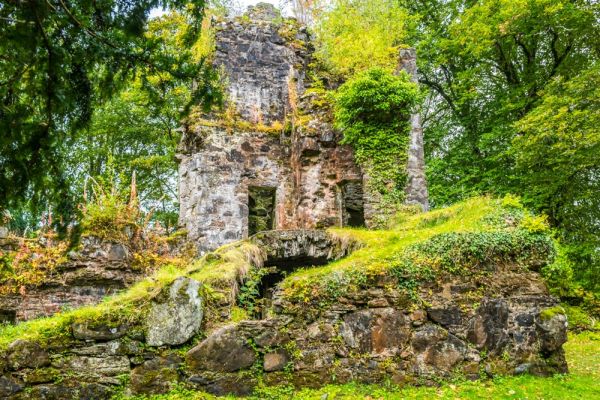
On the outskirts of Killin, a bridge leads across the River Dochart to the grim ruins of Finlarig Castle, the stronghold of Sir Duncan Campbell, the infamous 'Black Duncan' of Glenorchy. Sir Duncan (1550-1631) was the 7th Laird of Glenorchy. He is known for his castle-building exploits.
He built four castles that we know of; Finlarig, Balcardine Castle in Benderloch, Achalader Castle, Edinample Castle in Lochearnhead and Lochdochart Castle in Stirlingshire. He also strengthened and extended Kilchurn Castle. Including castles he inherited, such as Balloch (later Taymouth Castle) in Kenmore, Sir Duncan owned seven castles before he reached the age of 60. He was able to boast that he could cross his vast estates and spend one night at each of his own castles on his own land.
It is no wonder that he bore the nickname 'Duncan of the Castles'.
In 1584 Sir Duncan was named 7th Earl of Argyll by James VI, and he was knighted 9 years later at the coronation of Queen Anne. He was later made 1st Baronet Campbell of Glenorchy and was appointed Sheriff of Perthshire for life.
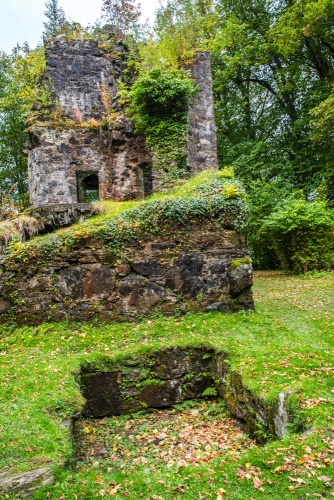
Sir Duncan was ruthless in his quest for more land and is accused of murdering Campbell of Cawdor in an attempt to become chief of Clan Campbell. He also tried to have the MacGregors outlawed so he could seize their lands.
By the time of his death in 1631, he owned some 438,000 acres of land, with estates stretching 100 miles. He was buried at Finlarig Castle, possibly in the chapel that once stood where the mausoleum is today.
In 1651 Finlarig hosted a gathering of the Scottish Parliament. Unfortunately, this was a time of civil war and only three MPs attended.
We know that the famous outlaw Rob Roy MacGregor visited Finlarig in 1713 and the castle was later garrisoned by government troops during the Jacobite Rebellion. It seems to be after this time that the castle was allowed to decay, becoming a romantic, crumbling ruin.
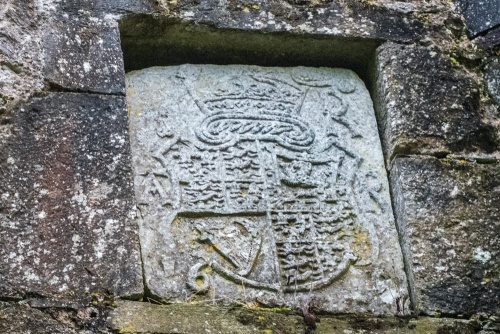
Castle History
Finlarig Castle dates to the 11th century and the lands were held by the Menzies family for several centuries before they became part of the Campbell estates. The medieval stronghold was rebuilt by Sir Duncan Campbell in the early 17th century.
Over the only intact entrance, on the south wall, are the coat of arms of James I and Queen Anne and their initials, a sign of the royal approval the Campbells enjoyed. The coat of arms bears the date 1609 (though the third digit is hard to read and might be a 2, making the date 1629).
At the foot of the castle tower is a deep rectangular pit, looking like an oversized grave. The analogy is apt, for according to popular belief this is the Beheading Pit. Legend tells that it was here that the Campbell lairds of Finlarig watched from the castle windows as their victims were executed as after-dinner entertainment.
Near the pit is a stone block with a concave top for the victim's head and neck. The pit, also known as the Execution Pit, measures 3.1m x 2.3m and 1.2m deep. Short lengths of iron chain were found fixed to one side of the pit.
Grim legends notwithstanding, some experts think that the 'Beheading Pit' is nothing more than a large water cistern, and the stories attached to it are just that; stories.
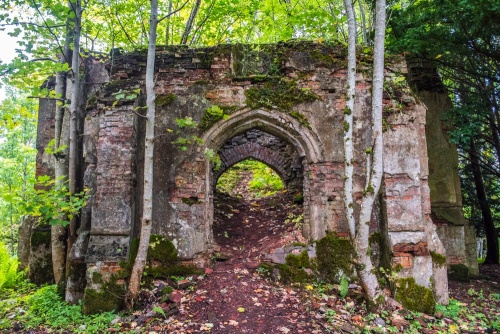
Beheading was a punishment only granted to nobility, Common people were executed by hanging from a nearby oak tree known as the Gallows Tree. The branch from which miscreants were hanged was cut off in the mid-20th century and it was noted that there was a deep groove in the wood from the friction of the hanging rope over time.
The castle was built to either a Z-plan or an L-plan (the official Historic Environment Scotland listing doesn't seem sure). If it was a traditional Z-plan then the north-east angle tower has been torn down, for only one tower remains, in the south-west. You can see the outline of a spiral stair on the outer wall, which would support the idea of a second tower.
You can see shot-holes at ground level, useful for firing on attackers without risk of being fired upon.
The castle stands on a high mound, suggesting it was built atop the earlier medieval castle mound. Behind the castle is the mock-Tudor style Breadalbane Mausoleum, built in 1829 on the site of 1523 chapel built by Sir Colin Campbell, an ancestor of the Earls of Breadalbane.
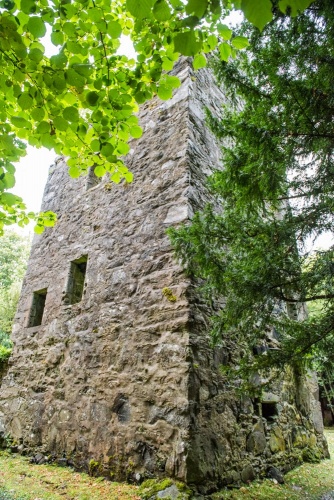
The mound is traditionally said to have been defended by a moat, but there is no evidence of a moat to be found today.
The castle is situated on private land, and there are posted signs warning that the ruins may be unsafe, so be warned!
Getting There
The castle is not signposted but it is very easy to reach. At the northern end of Killin, before you reach the Glen Lochay Bridge, turn east (right) onto Pier Road, signposted to the cemetery. Opposite the cemetery is a small parking area. From the parking area, you can see the ruined tower of Finlarig Castle just ahead, barely visible through the trees.
Please heed to signs and do not enter the castle ruins, due to the danger of falling masonry. You can get perfectly reasonable views of the castle and the mausoleum without putting yourself in danger from the decrepit buildings.
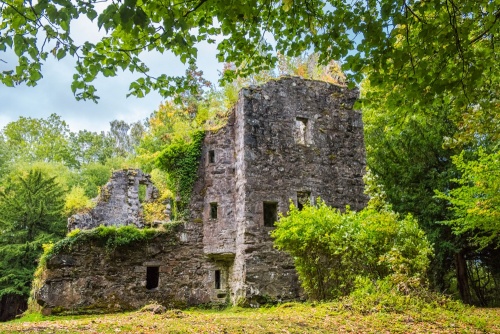
About Finlarig Castle
Address: Pier Road,
Killin,
Central Scotland,
Scotland
Attraction Type: Castle
Location: On Pier Road, off the A827 between the northern edge of Killin and the Bridge of Lochay
Website: Finlarig Castle
Location map
OS: NN575338
Photo Credit: David Ross and Britain Express
POPULAR POSTS
HERITAGE
 We've 'tagged' this attraction information to help you find related historic attractions and learn more about major time periods mentioned.
We've 'tagged' this attraction information to help you find related historic attractions and learn more about major time periods mentioned.
Find other attractions tagged with:
NEARBY HISTORIC ATTRACTIONS
Heritage Rated from 1- 5 (low to exceptional) on historic interest
Ben Lawers Nature Reserve - 0.6 miles (Countryside) ![]()
Moirlanich Longhouse - 0.8 miles (Museum) ![]()
Breadalbane Folklore Centre - 0.8 miles (Museum) ![]()
Loch Earn - 7.2 miles (Countryside) ![]()
Praying Hands, Glen Lyon - 8.2 miles (Countryside) ![]()
Loch Tay - 9.5 miles (Countryside) ![]()
Acharn Hermitage - 12.7 miles (Historic Building) ![]()
Fortingall Yew & Church - 13.2 miles (Historic Church) ![]()



